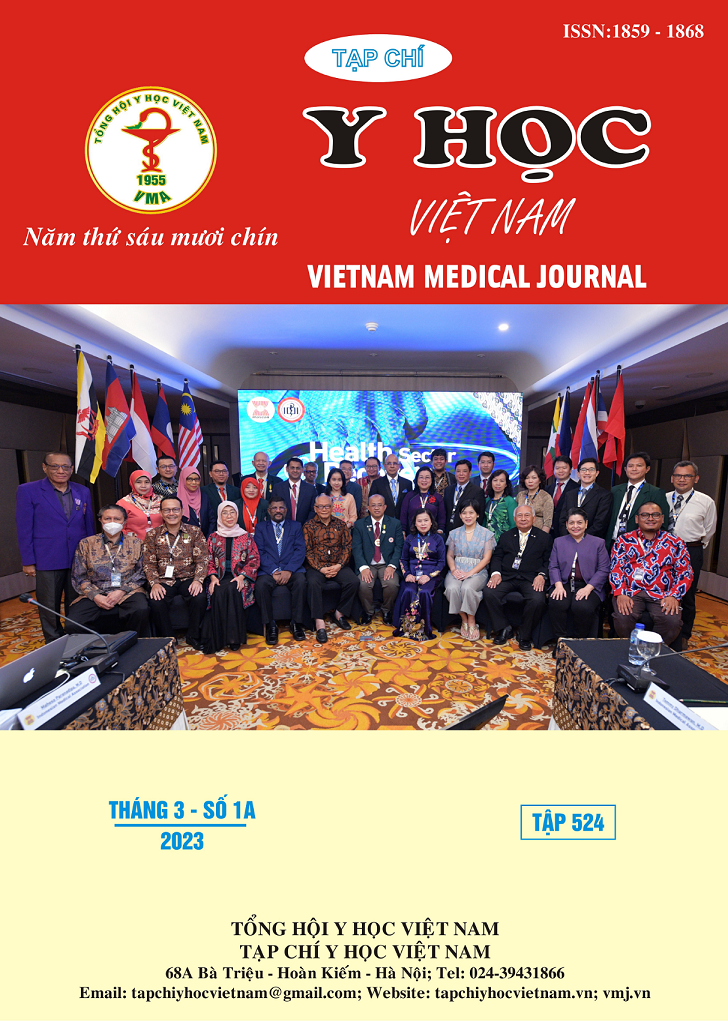HIỆU QUẢ CẢI THIỆN THỊ LỰC SAU ĐẶT THỂ THỦY TINH NHÂN TẠO PANOPTIX
Nội dung chính của bài viết
Tóm tắt
Mục tiêu: Đánh giá hiệu quả cải thiện thị lực sau đặt thể thủy tinh nhân tạo Panoptix. Đối tượng và phương pháp nghiên cứu: Mô tả, tiến cứu trên 35 mắt của bệnh nhân có chỉ định phẫu thuật Phaco đặt thể thủy tinh nhân tạo Pannoptix và đồng ý tham gia nghiên cứu tại Bệnh viện Mắt Nghệ An từ tháng 7 năm 2021 đến tháng 7 năm 2022. Kết quả: Có sự khác biệt có ý nghĩa thông kê (với p < 0,05) về: Thị lực nhìn xa chưa chỉnh kính và sau chỉnh kính tối đa ở các thời điểm 1 tuần, 1 tháng, 3 tháng sau phẫu thuật có sự cải thiện rõ ràng; Thị lực trung gian chưa chỉnh kính và sau chỉnh kính tối đa tại các thời điểm nghiên cứu đều có sự cải thiện so với thời điểm trước phẫu thuật; Kết quả thị lực nhìn gần chưa chỉnh kính và sau chỉnh kính tối đa cho thấy tại tất cả các thời điểm khám lại sau phẫu thuật so với thời điểm trước phẫu thuật đều có sự cải thiện; Ở các thời điểm sau phẫu thuật 1 tuần, 1 tháng và 3 tháng có sự giảm nhãn áp trung bình so với trước phẫu thuật. Không có sự khác biệt có ý nghĩa thống kê (với p > 0,05) về: Thị lực nhìn xa sau chỉnh kính giữa 1 tháng và 3 tháng sau phẫu thuật; thị lực gần 1 tháng và 3 tháng sau phẫu thuật; nhãn áp trung bình từ sau 1 tuần đến 1 tháng, 3 tháng
Chi tiết bài viết
Từ khóa
Ba tiêu cự, Panoptix, Thể thủy tinh nhân tạo, Đục thể thủy tinh
Tài liệu tham khảo
2. Sheppard AL, Shah S, Bhatt U et al (2013). Visual outcomes and subjective experience after bilateral implantation of a new diffractive trifocal intraocular lens. J Cataract Refract Surg, 39(3), 343-9.
3. Cochener B, Vryghem J, Rozot P et al (2012). Visual and refractive outcomes after implantation of a fully diffractive trifocal lens. Clin Ophthalmol, 6, 1421-7.
4. Carson D, Hill WE, Hong X et al (2014). Optical bench performance of AcrySof IQ ReSTOR, AT LISA tri, and Fine Vision intraocular lenses. Clin Ophthalmol, 14, 8, 2105-13.
5. Madrid-Costa D, Ruiz-Alcocer J, Ferrer-Blasco T et al (2013). Optical quality differences between three multifocal intraocular lenses: bifocal low add, bifocal moderate add, and trifocal. J Refract Surg, 29(11), 749-54.
6. Vryghem JC, Heireman S (2013). Visual performance after the implantation of a new trifocal intraocular lens. Clin Ophthalmol, 7, 1957-65.
7. Mojzis P, Peña-Garcίa P, Liehneova I et al (2014). Outcomes of a new diffractive trifocal intraocular lens. J Cataract Refract Surg, 40(1), 60-9.
8. Law EM, Aggarwal RK, Kasaby H (2014). Clinical outcomes with a new trifocal intraocular lens. Eur J Ophthalmol, 24(4), 501-8.
9. Vianna LM, Oliveira F, Pedro A et al (2014). Visual outcomes of the diffractive multifocal intraocular lens – Zeiss AT Lisa 809M. Rev. bras. Oftalmol., vol.73, no.2.
10. Trần Thế Hưng (2005). Nghiên cứu sự thay đổi nhãn áp sau mổ tán nhuyễn thể thủy tinh đục, đặt thể thủy tinh nhân tạo hậu phòng, Luận văn thạc sỹ y học, Đại học Y Hà Nội.


